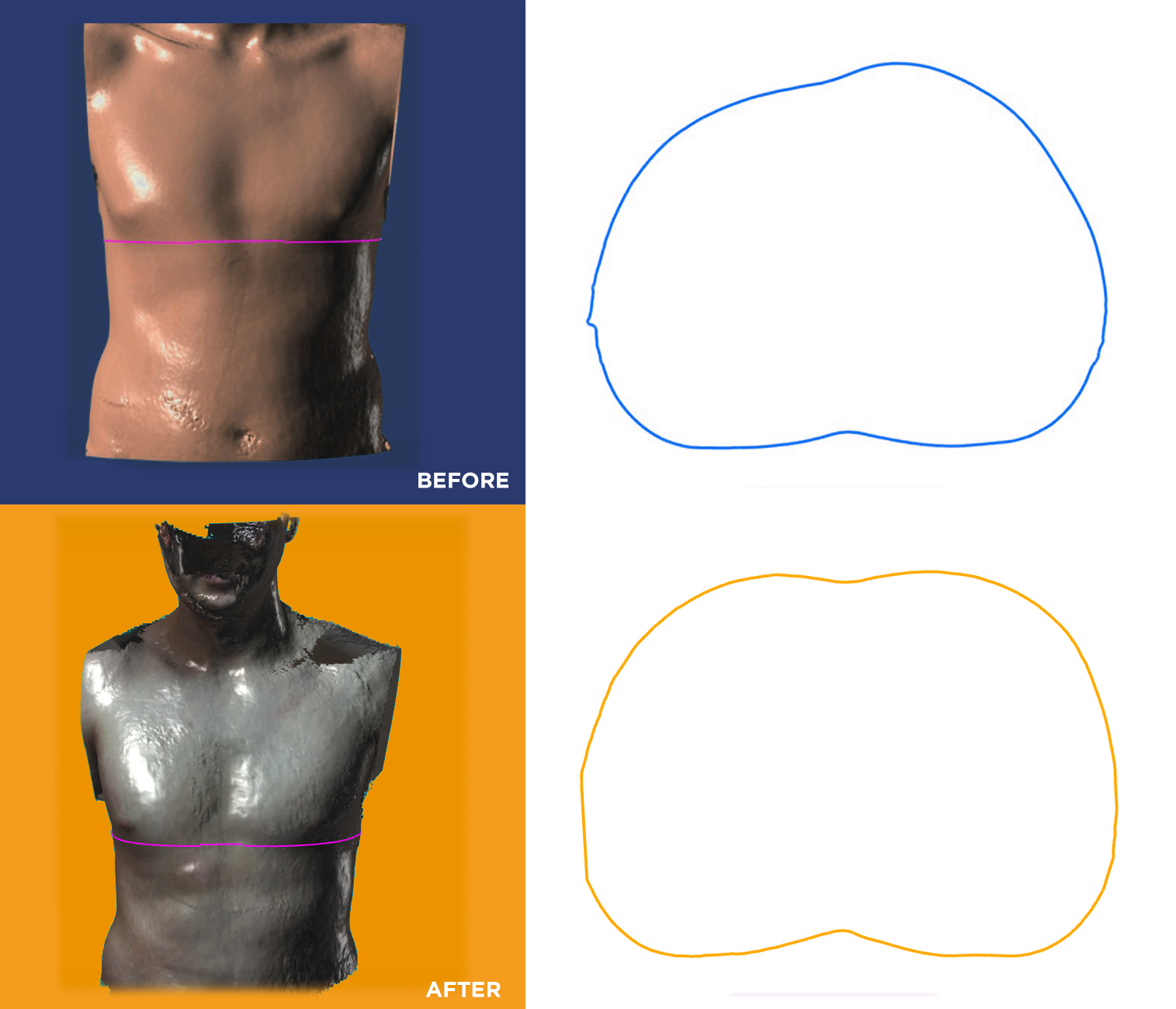
08 June 2022
"I think I first noticed my condition when I was around 10 or 11 years old. I think somewhere between 6th and 7th grade is when my deformity really took shape, and it was immediately damaging to my self-image. I was introverted already and so didn’t tell too many people.
Around the end of my college years, I remember my chest bothering me once again and decided to search for possible treatment. This is when I was dumbstruck to find that there were solutions, and I quickly decided to research the bracing option in-depth as this seemed the safest first course of action.
I ultimately came across a promising local clinic in LA and decided to go through the bracing process with them. I ended up getting a mid-quality brace and wearing it for 6 months while I was working full-time, and at the end of that time, I had to stop prematurely due to severe discomfort. I unfortunately didn’t get much correction out of that bracing treatment, and I once again had to accept that I might live with my deformed chest forever.
Fast forward 3 years and I moved to Japan for work and was still living with my deformed chest when I got hit with another wave of frustration about my appearance. Ultimately, I decided to look back into bracing therapy, and that’s when I stumbled across the London Orthotic Consultancy."
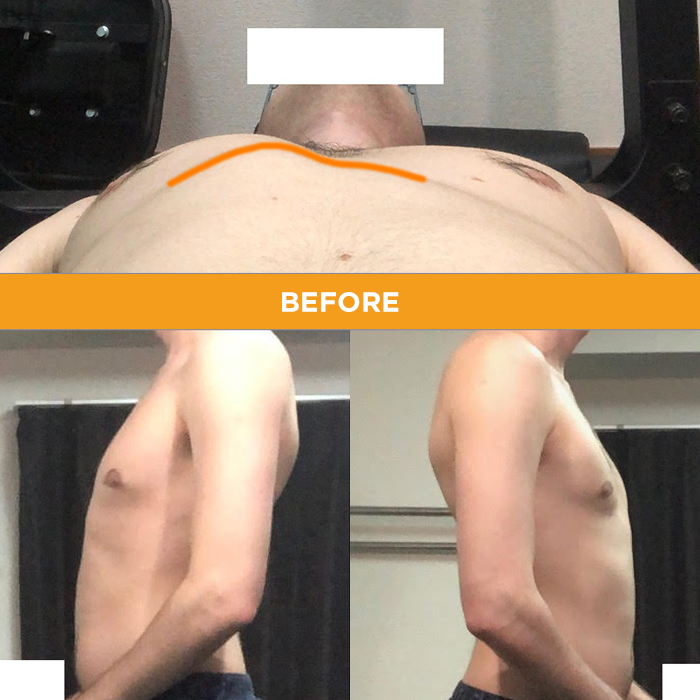
Sean's chest profiles before treatment
I had my initial consultation with Sam Walmsley (Lead Orthotist and Director of LOC) in early January 2020 and was immediately pleased with his realism and non-sales-ey approach. Sam was the real deal, and I could tell that he truly cared about getting a good outcome for his patients and that was all.
This was all right before COVID happened, and my original plan was to fly to London to see Sam, get fitted, then fly back to Japan and carry out my programme there with virtual check-ins. However, shortly after, the world shut down and I had to rethink my options. I temporarily put the bracing treatment on the shelf as I navigated changes in other areas of my life, but ultimately reached out to Sam again in late 2020, at age 26, and discussed with him the idea of doing my bracing treatment completely remotely.
The idea was to use the LOC Scanner app to get a good 3D scan of my chest, send it to Sam and hop on a few calls with him so we could really get a good measurement of my chest. Ultimately Sam ended up sending me the brace in early December 2020, along with a few tools and extra parts in case I needed to adjust the brace myself while in Japan. From here I successfully completed the bracing programme as a 26-year-old."
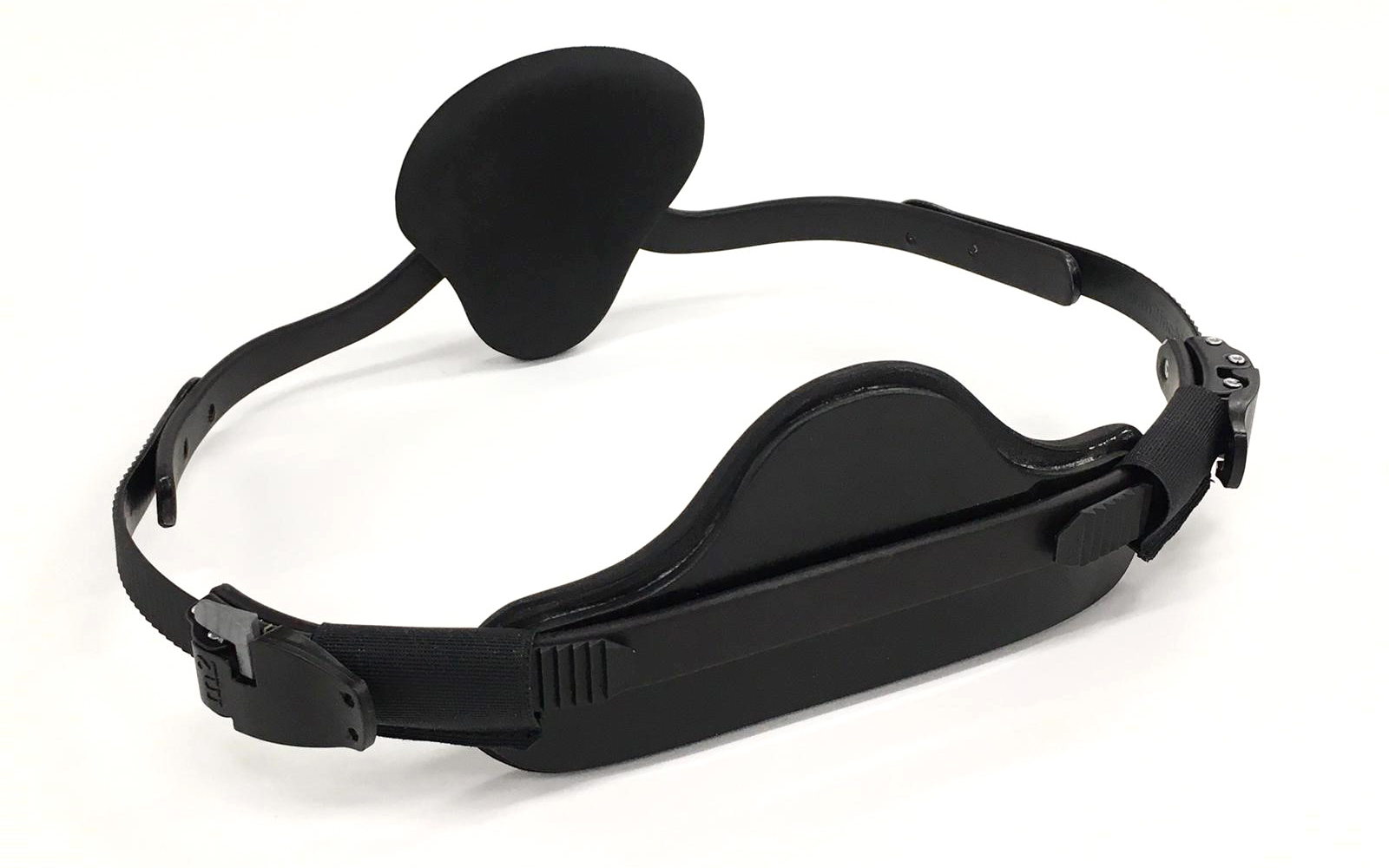
LOC's Dynamic Chest Compressor
Over the initial months, I checked in regularly with Sam and was able to wear the brace up to 23 hours a day within a month or so. I was sleeping in the brace fine soon as well, and one big thing I can say for sure is that this brace was much more comfortable and higher quality than the one I tried previously in LA.
I think for me, there was a turning point about 5 or 6 months in; while I had seen an improvement in my chest shape as quickly as 6 – 8 weeks in, my skin issues and general discomfort were really a barrier to me feeling optimistic about the process. But somewhere around the 5-month mark, I finally got a handle on the skin issues, and had Sam send a new brace pad that I thought would better suppress my deformity, and also the chest shape started really changing. At this point, I felt a lot more confident about the process and was also used to wearing the brace so much that the next 6 months seemed much more doable to me.
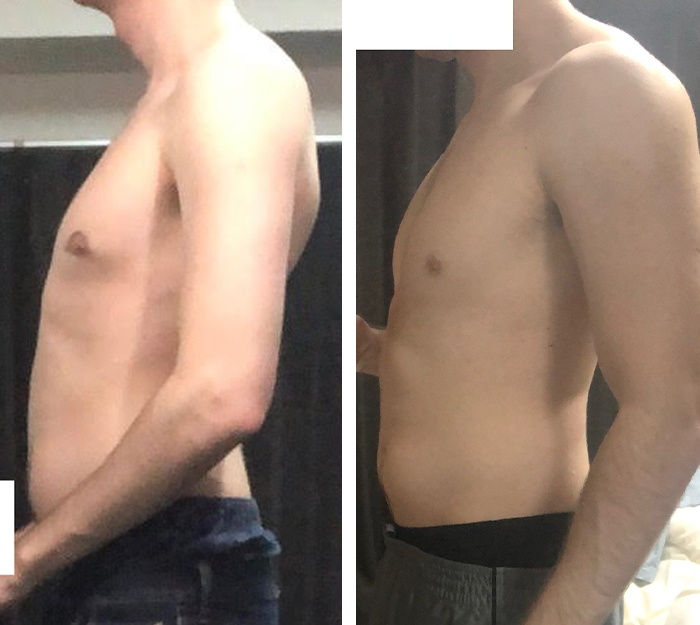
Sean's side profile before (left) after treatment (right)
The last 6 months were about me continuing to exercise, and eventually, start transitioning from just stretch exercises to heavier weightlifting exercises. The idea behind weightlifting is that it applies stress and pressure to your chest bone, which is in a new and still impermanent shape, and so this stress should theoretically sort of cement your chest in place.
The last months of treatment carried on like this – wearing the brace all day, working out hard, taking the brace off for a shower, and repeat. It was finally around January 2022 (over a year after initially starting the treatment) that Sam & I agreed to start winding down. We started by taking the brace off for 2 hours a day, seeing how my chest responded, then slowly working our way up to 5, 6, 8 hours, and then eventually nighttime only. At this point I was just so happy to be out of the brace for the day, it felt like coming out of prison and being a free man again.
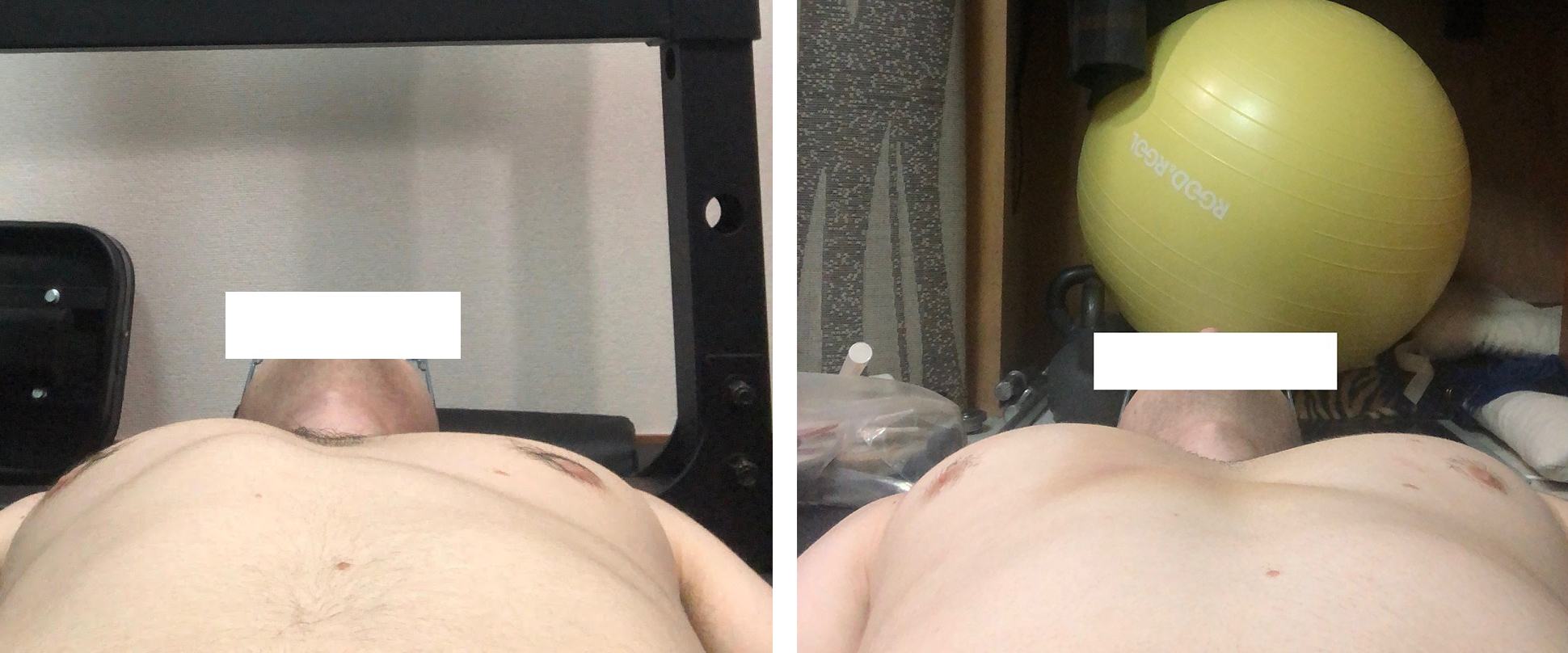
Sean's lay down profile before (left) after treatment (right)
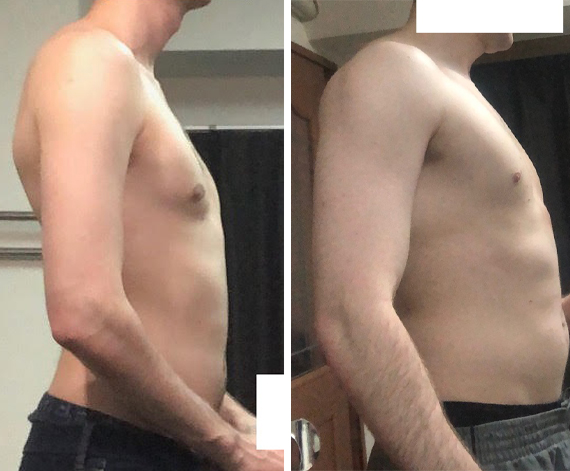
Sean's side profile before (left) after treatment (right)
I encourage anybody thinking about pectus bracing to strongly consider LOC, as I wholeheartedly recommend them, I am also willing to speak with others who want to get more info or have any questions. It’s a rare deformity, and thus can be a lonely experience when you feel you are the only person in the world with your deformed chest but know that you are not alone – there are thousands of others going through the same thing, and many of those people have successfully treated the issue, even as an adult."

3D scan & 2D pectus carinatum cross section, before (top) after (below)
You can see Sean talking to Sam about his pectus treatment in the above pectus testimonial Youtube video.
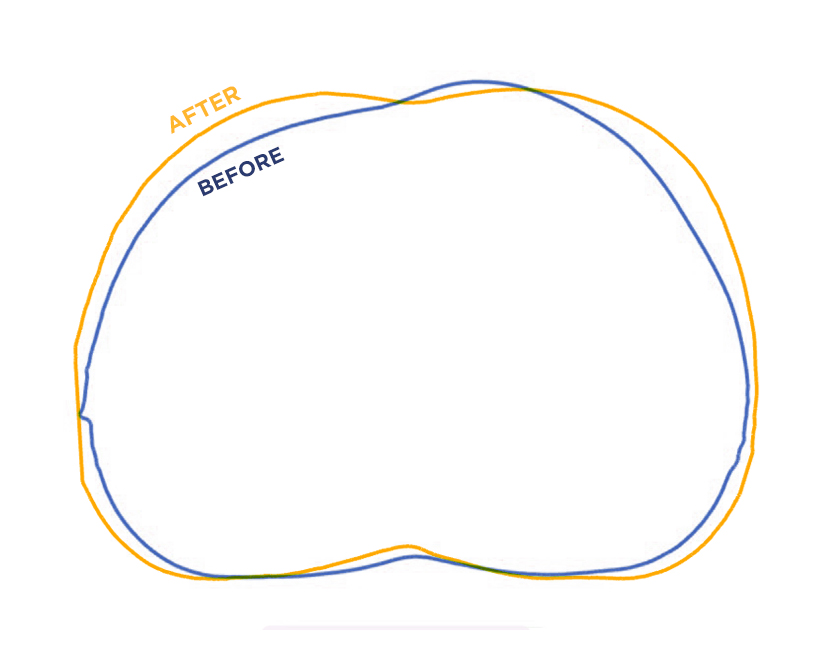
Overlay of Sean's before & after scan
For patients considering LOC’s non-surgical treatments for pectus carinatum, the initial virtual consultation is FREE with no obligation to proceed. During the consultation, one of LOC's clinicians will examine your chest and general posture.
If the clinician believes that your chest shape will respond using the dynamic remodelling method and that you are willing to commit to the exercise programme, they will take 3D scans of your chest shape. Further appointments will be made for casting and fitting and you will need to attend the clinic for regular reviews.
This depends on several factors; the position of the chest wall deformity, its severity, the flexibility of the chest, the kind of results wanting to be achieved and the age of the person undergoing treatment for pectus excavatum or pectus carinatum.
Early adolescence (roughly between the ages of 12-16 years old) – is an optimum age to start treatment, given that the chest is still maturing, and flexible, permanent correction is more easily achievable. Once bracing treatment is complete and a patient has stopped growing, the deformity will not return. For younger pectus patients, conservative bracing is used to keep a deformity from worsening and can help them to avoid surgery in later life.
For older pectus patients (between the ages of 20 to 30) results can be harder to achieve, as the costal cartilage hardens into the bone as a person matures. Over the years we have successfully treated many adults for both pectus excavatum and pectus carinatum and active adults with flexible chests can expect good results.
Again, this hugely depends on what a patient wants to achieve from treatment; whether that’s avoidance of surgery, improvement in the appearance of the chest shape, reduction in rib flaring etc. All these goals are taken into consideration during your first consultation. While there are no serious health risks of having pectus carinatum or excavatum – beyond the cosmetic – for many patients and parents, treatment outcomes involve improving confidence and self-esteem. During our 2018 Pectus Patient Survey, 92% of pectus carinatum patients surveyed said that treatment had a ‘major improvement’ or ‘an improvement’ on their social life.
You can read the results of our 2018 Pectus Patient Survey and quality of life questionnaire here.
Regular reviews are part of the treatment programme, preferably in clinic with one of our specialist orthotists, or via Skype consultations.
The number of appointments needed will vary from patient to patient but as a general rule, younger pectus patients who are growing at a faster rate will need to be seen more regularly for check-up appointments. This is to ensure that the brace fits well and is guiding the chest into the correct position as growth spurts occur. For other patients, this can be scaled back according to their individual needs and demands.
Regular appointments are beneficial for assessing progress, checking for signs of rubbing and determining whether another brace is needed. Appointments are also good for checking patient compliance to brace wearing and the breathing and exercise programme. At each appointment, we make time for patients to see our physiotherapist to fine-tune their exercise programme and check to see how a patient has been managing with the current programme.
We always advise coming in for appointments whenever you have any concerns about the brace or treatment programme, especially if a brace is rubbing or not fitting correctly. At the London Orthotic Consultancy, we have treated numerous international patients that have benefitted from specially designed braces that leave room to accommodate for growth and that can be adjusted remotely. Follow-up appointments for international patients are conducted via Skype.
This is a very common concern for patients considering treatment; in general, the dynamic chest compressor brace is easy to conceal if you are wearing a loose-fitting shirt for school or work. If you are wearing two chest braces – one for the main deformity and the other for rib flaring – then this may be more noticeable, especially under a t-shirt. Normally loose-fitting clothing will conceal the brace, though it’s likely it will be seen through tight-fitting clothes.
It is really important to continue exercising while going through bracing treatment. Exercise is fundamental to keeping the chest wall flexible. Our treatment programme incorporates a daily exercise routine of around 30-40 minutes of stretching using yoga poses, resistance bands, deep breathing exercises and general muscle stretches. Deep breathing exercises allow the lungs to expand against the chest wall, pushing it outwards.
Exercising with the brace on in the later stages of treatment can also make the chest correction more stable and permanent.
Swimming is one of the best forms of exercise to complement bracing treatment, as the body positions required to swim imitate the resistance band training designed to stretch the chest and increase its flexibility. Some swimming strokes are better for this than others, please check with your clinician. The brace should always be removed for contact sports and for swimming.
For most patients, one brace is often all that is needed to achieve a desired level of correction. They are each designed to last the duration of treatment and accommodate any growth that may occur in that time. Some patients have benefitted from having two braces – one to treat the main deformity and the other to treat rib flaring. For some pectus excavatum patients, having a brace apply pressure to the ribs – in addition to vacuum bell therapy – can greatly reduce the appearance of the depressed sternum area of the chest, forcing it upwards and outwards into a more corrective position.
If you are worried about your chest shape, or your child’s chest shape, then get in touch for a free Skype consultation with one of our pectus specialists who can assess their chest and discuss treatment options. We are always happy to communicate with local GPs, thoracic surgeons and consultants if a patient approaches us for bracing treatment after considering other options.